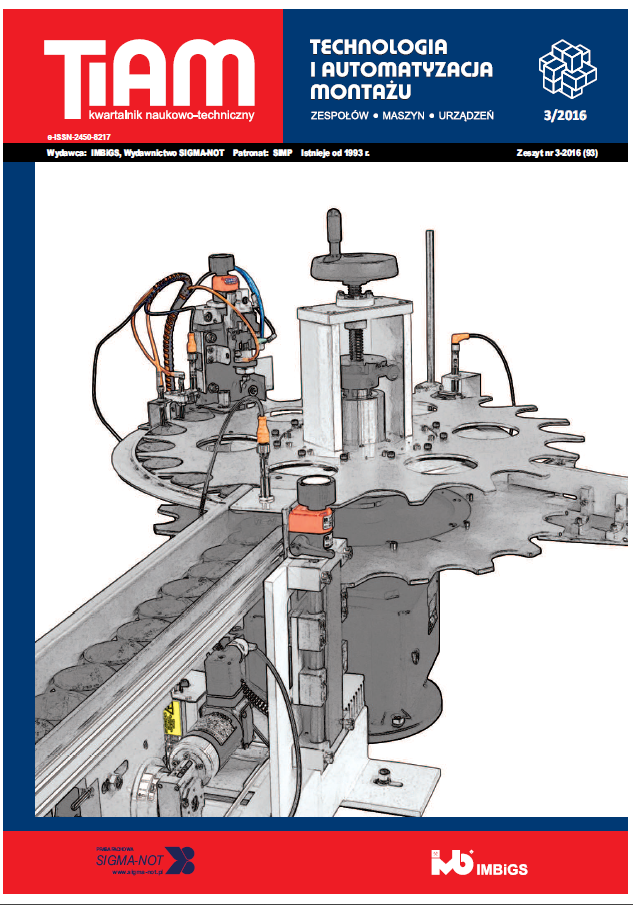Abstract
The paper presents the experimental research focused on the impact of selected technological and operational factors on the strength of adhesive joints of titanium sheet. The single-lap joints of titanium sheet of 0.64 mm thickness were tested, which were subjected to shear. The type of adhesive as technological factor and seasoning time in ambient conditions as operational factor were considered. Two types of two-component epoxy adhesives: Epidian 57/PAC/100:100 and Epidian 57/Z1/100:10 were used. Three variants of the seasoning time: 14, 21 and 28 days and prepared reference samples, for which the curing time was 7 days, were tested. Curing is carried out at an ambient temperature of 25 ± 2°C. The adhesive joints were destructive tested. The shear strength, in accordance with DIN EN 1465, were tested in Zwick/Roell Z150 strength machine. On the basis of the results of research it has been noted that the largest shear strength of CP2 titanium sheet adhesive joints preparing by Epidianu 57/PAC/1:1 was obtained. In addition, in both cases of tested CP2 titanium sheet adhesive joints making by epoxy adhesives Epidian 57/PAC/100:100 and Epidian 57/Z1/100:10, the highest values of the strength of these joints were achieved after 7 days of curing.
This is an Open Access article distributed under the terms of the Creative Commons Attribution License CC BY 4.0 (https://creativecommons.org/licenses/by/4.0/)
References
Czaplicki J. i in. 1987. „Klejenie tworzyw konstrukcyjnych”. Warszawa: WKiŁ.
Godzimirski J. 1993. „Wpływ czynników konstrukcyjnych i technologicznych na wytrzymałość połączeń klejowych”. Przegląd Mechaniczny (13): 18–21.
„Kleje i klejenie. Poradnik inżyniera i technika” red. Charles V. Cagle. 1977. Warszawa: WNT.
Brockmann W. et. al. 2009. “Adhesive Bonding. Materials, Applications and Technology”. Weinheim: Wiley- VCH.
Kuczmaszewski J. 1995. „Podstawy konstrukcyjne i technologiczne oceny wytrzymałości adhezyjnych połączeń metali”. Wydawnictwa Uczelniane Politechniki Lubelskiej.
Rudawska A. 2013. „Wybrane zagadnienia konstytuowania połączeń adhezyjnych jednorodnych i hybrydowych”. Wydawnictwa Uczelniane Politechniki Lubelskiej.
Rudawska A. 2009. „Wytrzymałość połączeń klejowych blach tytanowych po różnych sposobach przygotowania powierzchni”. Inżyniera Materiałowa (5): 341–345.
Brojer Z., Z. Hertz, P. Pczek. 1982. „Żywice epoksydowe”. Warszawa: WNT.
Ellis B. 1993. “Chemistry and Technology of Epoxy Resins”. Dordrecht: Springer Science+Business Media.
Tsuchida K., J.P. Bell. 2000. “A new epoxy/episulfide resin system for coating applications: curing mechanism and properties”. International Journal of Adhesion and Adhesives (20): 449–456.
Lapique F., K. Redford. 2002. “Curing effects on viscosity and mechanical properties of a commercial epoxy resin adhesive”. International Journal of Adhesion and Adhesives (22): 337–346.
Du S. et. al. 2004. “Cure kinetics of epoxy resin used for advanced composites”. Polymer International (53): 1343–1347.
Rudawska A., M. Czarnota. 2013. “Selected aspects of epoxy adhesive compositions curing process”. Journal Adhesion Science and Technology (27): 1933–1950.
ASTM B265-15 Standard Specifiation for Titanium and Titanium Alloy Strip, Sheet, and Plate.
Rudawska A., Ł. Dzwonkowski. „Przyrząd do ustalania próbek połączeń klejowych, zwłaszcza powierzchni płaskich”. Zgłoszenie patentowe P403112.
DIN EN 1465. Adhesives. Determination of tensile lap-shear strength of bonded joints.

